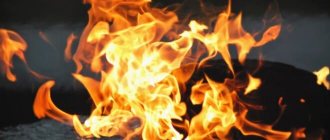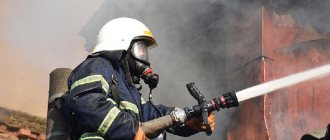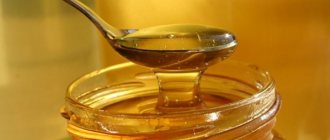Why doesn't the water burn? What does chemistry say?
To understand why water does not burn, you must first remember what the combustion process itself is. Chemistry says: combustion is a process of chemical oxidation that releases a lot of heat. To be more precise in formulation, combustion can be defined as the very rapid combination of some chemical element with oxygen (this is called oxidation). As you know, each chemical substance has its own formula. For water, this formula is H2O, that is, hydrogen oxide.
Therefore, from the name and composition of the formula it is clear: water is a combustion product, because the hydrogen in its composition has already reacted with oxygen and oxidized (burnt). The hydrogen atoms in water molecules are not free; they are bound to oxygen atoms.
But to say that water, in principle, cannot burn is not entirely true. To burn, water needs contact with an oxidizing agent, even stronger than oxygen. One of these oxidizing agents, for example, is fluorine, with which both hydrogen and oxygen react in water. True, it is possible to see how this combustion occurs only in laboratory conditions.
The bond between the hydrogen and oxygen atoms weakens, fluorine, as an aggressive electronegative element, displaces oxygen from its compound and as a result, hydrofluoric acid and oxygen are formed.
Why can't an oil fire be extinguished with water?
You have probably seen more than once in films or news how oil spilled on the surface of the sea burns. The expression “on the surface” was not chosen by chance: the oil’s properties are much lighter than water and when poured, it does not mix with it, but rises to the surface.
Read also: Tympanoplasty (hearing restoration)
Therefore, oil cannot be extinguished with water: foam, powder, and carbon dioxide fire extinguishers are used to extinguish burning oil products. The main task of the contents of the fire extinguisher in this case is to prevent air from entering the burning oil.
Why can't a kerosene fire be extinguished with water?
For the same reason: kerosene is obtained by distillation or rectification of oil, and oil, as we remember, is a much lighter substance than water. The density of kerosene is also much lower than the density of water, and if you pour water on burning kerosene, it will immediately float to the surface and continue to burn.
Why can't a gasoline fire be extinguished with water?
Gasoline is also made from petroleum, and its properties in relation to water and the combustion process are similar: it burns on the surface of water. In this case, the more water spreads, which is used to extinguish burning gasoline, the wider the flame spreads.
If you don't have a fire extinguisher on hand, you can use sand, baking soda, soil, thick cloth, or blankets to extinguish the gas.
Powder and carbon dioxide fire extinguishers: distinctive features and operating rules
Fire extinguishing agents based on chemical or air-mechanical foam are gradually becoming a thing of the past. Today, to extinguish fires, powder and carbon dioxide fire extinguishers , which are more versatile and effective.
It is quite difficult to answer unequivocally which type is better, since each option has specific features that determine the scope of application. To make the right choice, you need to know the composition, operating principle and main characteristics of these fire extinguishing agents.
Chemical composition and principle of action
The main difference between powder and carbon dioxide fire extinguishers is the composition of the fire extinguishing agent (FSA) and the principle of its effect on the flammable material:
- Fire extinguishing powders are finely ground mineral salts that include various additives to prevent caking. The basis is phosphorus-ammonium salts, as well as sodium and potassium bicarbonate. Additives are usually hydrophobic substances such as aerosil, white soot and others. When the powder is sprayed over a surface, it creates a protective film that prevents air from penetrating and thus helps extinguish the fire.
- Carbon dioxide plants are charged with carbon dioxide, which is in a cylinder in liquid form. Due to chemical changes in the process of converting the liquid mixture into gas, the material is sharply cooled to -70°C. In addition to reducing the surface temperature, carbon dioxide displaces oxygen, which also helps to stop the fire.
On the left is a powder fire extinguisher, on the right is a carbon dioxide one.
One of the advantages of carbon dioxide products is the complete evaporation of the chemical agent and, as a result, the absence of its traces on the treated surface.
Therefore, it is beneficial to use such devices in residential premises, for example, to extinguish a fire caused by improper operation of a gas boiler.
By the way, you can read about the rules for installing a gas boiler in the article: installing a gas boiler in a private house: basic criteria.
Characteristics of fire extinguishing agents: fire class and fire extinguishing ability
There are 5 fire classes, each of which is designated by a specific letter of the Latin alphabet:
- A – hard materials (paper, plastic, wood);
- B – flammable liquids (gasoline, solvents);
- C – flammable gases (methane, propane-butane);
- D – metals (magnesium, lithium, sodium);
- E – installations under voltage.
The effectiveness of fighting a fire of a particular class is determined by a special characteristic - fire extinguishing ability, which is expressed by a numerical value, for example 2A or 55B.
It is worth noting that powder substances are used for processing solid materials, since carbon dioxide is ineffective in this case.
At the same time, carbon dioxide is successfully used to extinguish fires in electrical installations operating under voltages of up to 10,000 V.
Table comparing the use of different types of fire extinguishers for different classes of fire
How to maintain powder and carbon dioxide fire extinguishers
The operation of such fire extinguishing means involves monitoring their constant readiness, which includes checking the appearance, condition of components and fastenings. If faults are identified during the inspection, then the device must be sent for repair.
An important point is the recharging time of the fire extinguishing agent, which is determined by the general technical condition, the degree of operation and the influence of the external environment.
If there is no visible damage to the body and the cylinder is stored in a dry room, recharging is carried out once every five years.
For powder fire extinguishers that are stored outdoors, this procedure must be performed every year.
The cylinder must be refilled by an organization that has a state license to carry out such work, as well as having special equipment and appropriate specialists.
You can also watch a video comparing these two types of fire extinguishers:
Attention! Burning oil!
You need to be even more careful with burning oil than with other products.
And here’s why you can’t put out burning oil with water: let’s get creative. You can imagine this situation: a frying pan with a large amount of vegetable oil was forgotten on the fire. First, the oil will heat up, then it will begin to boil, but at a temperature of 232°C the oil will begin to smoke, after which a fire will occur. The flame will simply blaze in the frying pan.
If you splash water onto the frying pan at this time, the situation will only worsen - the water (since it is lighter than oils) will immediately fall to the bottom, where it will instantly heat up and begin to boil, and at the same time, during boiling, the water will throw burning oil out of the frying pan onto long distance.
Not only will people nearby be seriously burned, but the fire will also be sprayed, increasing the area of the fire.
Dangerous zones during combustion in tank farms
Extinguishing fires of flammable liquids and flammable liquids should also be carried out taking into account hazardous factors and areas that can reduce the effectiveness of fire extinguishing measures:
- Formation of zones where it is impossible to deliver fire extinguishing agent.
- Warming up the flammable contents of the tank to a depth of 1 m or more.
- Reduced air temperature around the fire site.
- Ignition of several containers at the same time.
Extinguishing a real fire of flammable liquid bottling of a large area Angarsk 2014:
Why can't you extinguish with water?
What means cannot extinguish fuels and lubricants? The most important rule when extinguishing is that gasoline cannot be extinguished with water. This will only increase the fire area.
Fire is the combination of a burning substance with O2. When extinguishing a fire, it is necessary to eliminate the possibility of air flow to the source of fire. H2O acts as a barrier to oxygen. Water reduces the temperature of a burning object and envelops it.
However, with gasoline things are different. When GH and H2O are mixed, oxygen displacement does not occur. Gasoline is lighter than water. It just rises to the surface and continues to burn. In addition, the fire becomes larger due to the fact that gasoline spreads along with H2O.
Fire hazard of flammable liquids
Flammable liquids include substances with a low flash point (oil, acetone, kerosene, gasoline, etc.), which ignite in a matter of seconds. The danger of flammable liquids lies in their ability to maintain the combustion process after removing the ignition source. At any time of the year and at any air temperature, the slightest spark caught in such a substance can cause ignition.
Petrol
Refers to flammable liquids.
There are different types of gasoline brands:
- aviation;
- automobile.
The conditions and purpose of their use vary.
| Gasoline brands | Flash point, ℃ | Self-ignition temperature, ℃ | Ignition area by volume, % | Ignition temperature limits, ℃ |
| Aviation | from –34 to –38 | 380–475 | 0,99–5,48 | from –38 to +5 |
| Automotive | from –27 to –39 | 255–370 | 0,76–5,16 | from –39 to –8 |
Kerosene
This flammable substance can cause an explosion when heated above 37 degrees. The fire spreads rapidly if extinguishing is not started in time. Eliminate the source of fire with powder fire extinguishers. The substance irritates the nasopharynx and skin, so when extinguishing fires, rescuers must wear protective gloves and masks.
Composition and characteristics of kerosene, main properties of different types
The properties of kerosene have made it in demand in various fields. A transparent, oily liquid suitable for use as fuel, fuels and lubricants and all kinds of additives. Kerosene is resistant to low temperatures and has high combustion and evaporation rates. It is also compatible with raw materials having a different composition.
Kerosene, a petroleum product obtained by rectification and recycling of raw materials. In some cases, it is additionally hydrotreated
Foam fire extinguishing
Extinguishing flammable liquids and gases with low and medium expansion foam is the most popular way to fight fire. The advantage of foam is that it insulates the surface of the flammable liquid from the flame, which leads to a reduction in its evaporation and, accordingly, the volume of flammable gases in the air. This creates a solution of a foaming agent with cooling properties. In this way, convective heat and mass transfer is achieved, and the temperature level becomes the same throughout the entire depth of the container within 15 minutes from the start of using the foam.
Extinguishing flammable liquids using foam solutions of varying amounts depends on where the combustion occurs:
- low expansion rate for the lower part of the container, used for the “under-layer” extinguishing method, the fire extinguishing agent contains a fluorine-containing film-forming foaming agent, due to which, when the foam rises through a layer of flammable contents, it is not saturated with hydrocarbon vapors and retains its fire-extinguishing abilities; obtained using low-expansion foam trunks;
- medium expansion rate for surface extinguishing, foam is also inert, does not interact with flammable liquid vapors, cools the liquid, helps reduce the formation of an explosive air mixture; obtained using specialized foam generators of the GPS type.
After the extinguishing of flammable liquids and gases is completed, a thick foam layer forms on the surface of the liquid, protecting it from resumption of combustion.
When supplying fire extinguishing foam, the flame intensity should be maintained at 0.15 l/s.
Foam fire extinguishing can be carried out using three methods:
- delivery of foam concentrate using a foam lifter and other similar equipment;
- delivery of foam to the surface of burning flammable liquids and gases using monitors;
- foam delivery through sublayer extinguishing.
Do not extinguish burning gasoline with water!
If you take a little (just a few drops) of gasoline and pour it in a safe place, then set it on fire, this liquid will instantly ignite and form a fire. Not surprising, since everyone has known for a long time that gasoline is a flammable liquid. Now you can try extinguishing gasoline with water. Nothing will come of this idea. The fire will continue to burn; moreover, somewhere it will flare up with renewed vigor.
But this is already interesting - everyone knows that water is stronger than fire, and it can put out any fire.
This is a misconception; there are substances that cannot be extinguished with water. It’s not for nothing that the fire extinguisher contains foam, not water.
Everything is explained simply. In order to extinguish a fire, it is necessary to stop the access of oxygen to it. If, for example, you can splash water on paper that has caught fire, the water will quickly fill the smallest space between the paper molecules and cover the paper so that no access to oxygen will be possible (and, therefore, the fire will “have nothing to breathe” and it will immediately go out) , then with gasoline everything is different. Water cannot completely cover drops of gasoline. Gasoline is lighter than water, which means it will constantly be on the surface, oxygen will continue to flow, and the fire will flare up more and more. The water will only roll down. Moreover, the “released” drops of gasoline can roll to another place, carrying the fire with them and expanding the combustion area.
Fire conditions
Since fire is a chemical reaction, like any reaction, it requires certain conditions for its occurrence and maintenance. In particular, the following 4 conditions are necessary for the existence of fire:
- Fuel or combustible substance, that is, any substance that can burn.
- An oxidizing agent, that is, a component of a chemical reaction that has oxidizing properties. In the case of fire, as a rule, oxygen in the air acts as an oxidizing agent.
- Heat, that is, the energy that is necessary for the fuel and oxidizer to begin to enter into a chemical reaction in a certain place and at a certain time.
- To maintain a fire in a stable state, it is necessary for the chemical combustion reaction to proceed in a chain manner.
When the combustion process begins, the heat generated creates the conditions for the process to continue, and as long as the fuel and oxidizer exist, the fire will not go out.
Effect of water in a fire
When water hits a burning object, the first thing it does is cool the topmost layer, which is heated and already exposed to fire. But the water also evaporates. At high temperatures, it instantly turns into steam, displaces air from the fire zone and dilutes the reacting substances. As a result, the fire goes out.
In addition, tiny drops of water penetrate the pores of burning materials, protecting the material itself from burning. When it hits an object engulfed in fire, it seems to envelop the object itself, the access of oxygen stops, and the fire subsides. But this doesn't always happen.
Instructions
Carefully cover fire spots with earth or sand so that gasoline does not spill, splash, or get on nearby objects, otherwise the fire will engulf them too. But before you do anything, remove to a safe distance all things that can catch fire and are close to the fire (furniture, curtains, etc.).
Then you will need to sprinkle sand or earth around the burning liquid. Next, fill from the edges to the middle. Once you have extinguished the fire, the sand (used to extinguish the fire) becomes toxic, so it will need to be buried away from public areas and areas where there are plants.
Water is not allowed, then what?
In order to put out a fire, you need to try to understand what is burning and what material the burning object is made of.
In addition to water, the following are also suitable:
- various powders - they are universal and suitable for extinguishing any fire;
- foam - it will be able to cope with fire that threatens liquid flammable substances. A carbon monoxide fire extinguisher is especially good for this. In addition, foam is most gentle on household items on which fire occurs;
- sand - used in fires that occur in the event of electrical failures. Every building should have a fire cabinet for sand and special fire extinguishing tools. To extinguish such a fire, you must first turn off the power to the entire room.
What are fire extinguishers for and what are they?
You are here: page » Fire protection » Primary means
Over its long history, humanity has learned to fight fires, developed fire safety measures, methods and methods of fighting fire, and invented fire extinguishing means. One of them is a fire extinguisher.
How to handle this fire extinguishing agent, what technical characteristics it has, what can and cannot be extinguished with fire extinguishers - our article answers all these questions.
What is a fire extinguisher
A fire extinguisher is a device designed to extinguish a fire. Extinguishing is carried out using a substance contained in the fire extinguisher that can extinguish the flame . A fire extinguisher can be either portable or mobile.











